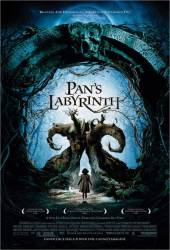Continuity mistake: As Mercedes flees after cutting the captain, her hair is done up in a braid, but in the next shot her hair is down and flowing. (01:34:05)
Continuity mistake: When Mercedes flees through the forest to escape the soldiers, the blood pattern, thickness and color of blood on her face changes between shots. (01:33:00 - 01:35:30)
Continuity mistake: The Captain has a piece of gauze on his wounded cheek, and over time, the gauze has a small amount of blood, to a lot, back to a little, and back and forth.
Continuity mistake: When the Captain is stitching his facial wound, the camera pans down to Ofelia hiding by his table, revealing that there is no blood on the Captain's clothing. Seconds later, the Captain approaches the table wearing bloodstained clothing (from the earlier scene with Mercedes). (01:38:20 - 01:39:05)






Answer: Evidence from the film:1) The image of a ram appears frequently in the house, including over the mother's bed and the twisted growth of the tree. An image such as this suggests that the fawn was created from common images.2) The first image is of the magical realm. The the following show Ofelia reading a fantasy book. This inidicates that the movie will be mostly from the point of view of a child who spends time developing her imagination. 3) The images of fascist, war-torn Spain are bleak aand desaturated while the images of the magical realm are bright. Even the monochromatic images of el Fauno are supersaturated. This filming technique suggests that Ofelia creates the fantasy.4) At the end of the movie, the General cannot see Ofelia talking to el Fauno. Therefore, at least for him, the kingdom is fantasy.The proof exists for both. The flower at the end of the film has been cited as evidence that the magical world certainly exists but only for those who choose to see it. This means that the kingdom is both real and not real - a paradox.